 Your new post is loading...

|
Scooped by
Patrick H.
|
Visakhapatnam: The ‘Sea-Acceptance’ trials of India’s first indigenous nuclear-powered submarine INS Arihant are on track and the naval authorities are satisfied with the progress. The 6,000-tonne submarine, which is capable of carrying nuclear missiles, is expected to be commissioned and inducted into the Indian Navy’s submarine fleet by the end of this year. Earlier, it was indicated that the commissioning will be done in 2017. However, the sea trials and the commissioning of the submarine have already been delayed by several years. According to the original schedule, the nuclear submarine, which was ceremonially launched on July 26, 2009, was supposed to go for sea trials in 2010 and formally inducted into the Indian Navy by 2011. “Sea trails have commenced and they are expected to be completed by this year-end. The submarine is going through all the safety procedures. There are several government agencies, committees and atomic bodies, and the nuclear submarine needs to undergo scrutiny at various levels. Several surface and deep sea dives have already been done. Overall, the submarine is on the right track and it will be commissioned by this year-end. We are taking baby steps in making nuclear submarines and need to take utmost care so that no untoward incident happens,” Eastern Naval Command Commander-in-Chief Vice-Admiral Satish Soni told this correspondent. INS Arihant had entered the open sea waters off Vizag coast on December 15 last year, in the presence of defence minister Manohar Parikkar, who kick-started the Sea-Acceptance trials. The launch of INS Arihant’s SATs were kept a secret, due to the sensitivity involved. SATs were taken up after a series of successful Harbour-Acceptance trials at the ship building centre in Vizag over a few months.

|
Scooped by
Patrick H.
|
VISAKHAPATNAM: India's first indigenous nuclear submarine INS Arihant had finally made its maiden foray into the wide-open sea in Bay of Bengal on Monday. The 6,000-tonne vessel commenced its sea trials off Visakhapatnam coast in the presence of defence minister Manohar Parrikar who was on his first visit to the Eastern Naval Command (ENC) in Visakhapatnam after taking charge of the post. The much-awaited milestone marking the sea trials of INS Arihant, was achieved within a fortnight after Navy chief admiral RK Dhowan said that the nuclear submarine will soon undergo sea trials. The top brass of Indian Navy at Eastern Naval Command (ENC), Nuclear Power Corporation of India (NPCI) and the Baba Atomic Research Centre (BARC) who are stationed in the city for the past couple of days, also witnessed the historical event. Parrikar who arrived by a special flight on Monday morning around 9 am, went to the Naval Dockyard in a convoy. During his brief visit, he was introduced to the ENC top officials followed by visit to the sea where INS Arihant took part in sea trials. Later, he left for Delhi by a special flight.

|
Scooped by
Patrick H.
|
In yet another accident involving the Navy, one civilian worker was killed and two were injured in an accident at the under-construction nuclear submarine at the shipbuilding centre of Eastern Naval Command (ENC) here tonight. The incident took place when the pressure of the hydraulic tank of the Arihant class submarine was being tested and the tank's lid fell on the workers of L & at Building-5 of the shipbuilding centre, Defence Research Development Organization (DRDO) chief Avinash Chander told PTI. He said one worker "unfortunately lost his life" in the incident. Police sources said 24-year-old Amar was killed on the spot while Amzad Khan and Vishnu were seriously injured and admitted to a private hospital in the city. The under-construction nuclear submarine was a follow-up of the Navy's warship INS Arihant. Chander said an inquiry has been ordered into the incident and maintained there was no setback to the programme for development of Arihant class submarines. Today's incident came a day after leakage of a deadly gas in an under-construction warship in Mumbai's Mazagon dock claimed the life of a Navy Commander.

|
Scooped by
Patrick H.
|
In a major boost to indigenisation of defence manufacturing, India's first nuclear-powered and nuclear-armed submarine INS Arihant will head out for sea trials by the year-end. "INS Arihant will be ready for sea trials by the end of this year," an official aware of the developments relating to the 6,000-tonne submarine told IANS, speaking on condition of anonymity. Once the trials are through and the submarine enters service, India will not only complete its nuclear triad of delivering nuclear weapons from land, sea and air, but also join an elite club of six nations that operate nuclear submarines carrying ballistic missiles. The US, Russia, France, Britain and China are the other nations with this capability. The INS Arihant's miniaturised nuclear reactor, built with Russian help, had gone critical last year and the vessel has been going through a series of harbour trials since then at Visakhapatnam, where it is being built. The submarine has also been going through the power-up cycle of its nuclear reactor and has now achieved a nearly 100 percent power level, the official said. "Its reactor had gone critical last year. We are now close to attaining 100 percent its power," the official said, adding: "The nuclear reaction is highly controlled. It is something similar to nuclear power plants, but extra caution is needed. The reactor is now functioning perfectly well," the official said. Once the submarine attains 100 percent power, it will head out to sea for its final trials, which will include the firing of the indigenous Bo5 missile that has a 700-km range and can carry a one tonne nuclear warhead. INS Arihant can carry 12 such missiles. The vessel, the lead ship of the Arihant-class submarines, was launched in 2009. Its design is based on the Russian Akula-1 class submarines and its 83MW pressurised heavy water reactor has been built with significant Russian assistance. While its 100-member crew has been trained by Russian specialists, Indian scientists at Mumbai's Bhabha Atomic Research Centre have received significant expertise in reducing the size of the reactor to help it fit into the 10 metre diameter hull of the submarine. The Indian Navy currently operates the INS Chakra nuclear-powered submarine leased for 10 years from Russia in 2012. Nuclear submarines stay out at sea for longer periods than diesel-electric powered boats and can also remain under water for longer durations. Conventional submarines have to surface at regular intervals for re-charging their batteries, making them vulnerable to detection. Two other vessels of the Arihant class are also believed to be under construction at Visakhapatnam's state-owned Hindustan Shipyard Limited.

|
Scooped by
Patrick H.
|
NEW DELHI: With India planning a larger fleet of nuclear-powered submarines, which can prowl underwater for several months at a time and let loose their nuclear-tipped missiles as and when required, the Navy has acquired a new advanced facility to communicate with the silent predators.
The state-of-the-art very low frequency (VLF) transmitting station was commissioned at INS Kattabomman in Tirunelveli (Tamil Nadu) by Navy chief Admiral RK Dhowan on Thursday.
"The new facility will boost our ability to communicate with submarines, which have trailing wire antenna to pick up the coded VLF radio waves, on an uninterrupted basis throughout the year," said an officer.
Only a handful of nations have such a VLF capability, which is critical to pass coded orders to nuclear submarines on long-range deterrent patrols. Diesel-electric submarines have to surface every few days to get oxygen to recharge their batteries and have limited endurance due to fuel requirements.
Nuclear-powered submarines, armed with nuclear-tipped missiles, in turn, are considered the most effective and difficult-to-detect nuke platform since they can operate underwater at long ranges for months at end.
India is down to just 13 old diesel-electric submarines, barely half of which are operational at any given time, and a single nuclear-propelled submarine INS Chakra on lease from Russia without any long-range missiles.
But India's first three SSBNs (nuclear-powered submarines with nuclear ballistic missiles) are already being built at the secretive Ship-Building Centre at Vizag to complete the country's nuclear weapons triad - the capability to fire nukes from land, air and underwater.
The first, the 6,000-tonne INS Arihant, is slated to go for extensive sea trials soon after its miniature 83MW pressurized light-water reactor, which went "critical" in August last year, attains "full power" in the next couple of months. Moreover, there is an ongoing proposal to build six SSNs (nuclear-powered attack submarines, usually without ballistic missiles), as reported by TOI earlier.

|
Scooped by
Patrick H.
|
NEW DELHI: Contrary to claims, India’s first indigenous nuclear-powered submarine INS Arihant is still not ready for sea trails, a stage critical for testing the vessel’s systems and weapons before it can be commissioned into the Navy. Arihant’s miniaturised nuclear reactor, built with Russian help, had gone critical in last August and since then the 6,000-tonne vessel has been put through a series of harbour acceptance trials, which could take a few more months, according to top navy sources here. The vessel, powered by a 83-MW pressurised light-water reactor operated with enriched uranium fuel, was to sail out for sea trials earlier this year, but the Navy has not been able to take the vessel out, as more tests are being conducted to ensure foolproof sea trials of all systems on board, sources said. The vessel going out to sea trials is critical for India to test its home-grown submarine-launched ballistic missile with nuclear weapon capability. The DRDO has already developed and successfully tested from a submerged pontoon a missile code-named Bo5, but called in popular parlance as K-15, having a 750-km range. Once Arihant goes for the sea trials and does a six-to-eight months of testing of systems, it will also get to fire the Bo5, 12 of which will be carried by the vessel. The DRDO has maintained that its missile is ready and is awaiting the Arihant to fire it and validate the nuclear triad. The DRDO is keenly awaiting that moment, as it will successfully complete India’s nuclear triad -- the capability to launch nuclear-capable ballistic missiles from surface, air and undersea platforms. The nuclear triad is critical for the country for a credible deterrence against a nuclear attack, considering that it has a stated ‘no first strike’ nuke doctrine. India currently operates Russian-origin nuclear-powered INS Chakra submarine, leased from Russia in 2012 for use by the Navy for 10 years for nearly `5,000 crore, primarily to gain experience in operating such a platform, considering that it plans to have a fleet of at least five such indigenous vessels in its fleet in the immediate future. India has maintained that its nuclear submarine fleet strength will be dictated by the maritime security dynamics of the Indian Ocean region and the extended neighbourhood.

|
Scooped by
Patrick H.
|
In yet another accident involving the Navy, one civilian worker was killed and two were injured in an accident at the under-construction nuclear submarine at the shipbuilding centre of Eastern Naval Command (ENC) in Visakhapatnam on Saturday night. The incident took place when the pressure of the hydraulic tank of the Arihant class submarine was being tested and the tank's lid fell on the workers of L & at Building-5 of the shipbuilding cente, Defence Research Development Organization (DRDO) chief Avinash Chander said. He said one worker "unfortunately lost his life" in the incident. Police sources said 24-year-old Amar was killed on the spot while Amzad Khan and Vishnu were seriously injured and admitted to a private hospital in the city. The under-construction nuclear submarine was a follow-up of the Navy's warship INS Arihant. Chander said an inquiry has been ordered into the incident and maintained there was no setback to the programme for development of Arihant class submarines. Today's incident came a day after leakage of a deadly gas in an under-construction warship in Mumbai's Mazagon dock claimed the life of a Navy Commander. This is the 12th incident involving naval assets in service in the recent past or which are expected to join the Navy in near future. Around 10 days ago, warship INS Sindhuratna had suffered a mishap under water when smoke and fire killed two officers and the incident led to the exit of former Navy Chief Admiral DK Joshi who resigned taking moral responsibility over the spate of incidents. The biggest mishap had occurred when the INS Sindhurakshak sank in Mumbai harbour, killing all the 18 personnel on board on August 14. Last month, INS Airavat, an amphibious warfare vessel, had run aground after which the commanding officer was stripped of his command duties. After the sinking of the INS Sindhurakshak, one of the mishaps involved INS Betwa which was damaged apparently after hitting an underwater object. India's leading minesweeper INS Konkan, that was undergoing repairs in Visakhapatnam, had caught fire and suffered major damage to its interiors. The Pondicherry-class minesweeper was getting a refit at a dry dock when the incident occurred. Under the Arihant class submarine development programme, India is building around three submarines which have not yet been named so far. The first vessel of the class INS Arihant is expected to be launched for sea trials within a month or two and these are expected to be completed within this year. Recently, Navy officials had said that after the trials of INS Arihant are completed, it would be ready for induction into operational service. The ATV project is directly under the DRDO and the Navy plays a significant role it it.

|
Scooped by
Patrick H.
|
NEW DELHI: The Navy is all gung-ho about the country's first indigenous nuclear submarine INS Arihant, declaring it will soon head for sea trials, complete the "nuclear weapons triad" and live up to its name "annihilator of enemies".
"We expect INS Arihant to finish its harbour trials in a few weeks, a month or so, and then head for sea trials. All its capabilities will be tested as the third leg of the triad, the sea-based strategic deterrence, which will include firing of its ballistic missiles," said assistant chief of naval staff (submarines) Rear Admiral LVS Babu on Tuesday.
This confidence about finally achieving its dream of deploying a nuclear-powered submarine armed with nuclear-tipped ballistic missiles — called a SSBN in military parlance — is reflected in the naval Republic Day tableau this year. It depicts models of INS Arihant and a submarine-launched ballistic missile (SLBM).
But the Navy wants more, at least three SSBNs and six SSNs (nuclear-powered attack submarines but without ballistic missiles) in the long term. Consequently, the work on the hulls of the follow-on SSBNs to INS Arihant is already in progress at the ship-building centre at Visakhapatnam, with the second one to be named INS Aridhaman.
Concurrently, India is also negotiating the lease of a second Akula-II class SSN from Russia, at a cost of about $1.5 billion, after inducting the first one INS Chakra on a 10-year lease since April 2012 after paying almost $1 billion.
Nuclear submarines, which can stay underwater for prolonged periods unlike conventional diesel-electric submarines, are the hard currency of stealth combat power. The US leads the pack with around 70 nuclear submarines, followed by Russia with over 30, and China, UK and France with about 8-12 each.
India for long has had the Agni missiles and aircraft that can double up as strategic bombers as the first two legs of the nuclear triad. But the underwater one in the shape of a SSBN, considered the most effective and difficult-to-detect leg, was elusive so far.
INS Arihant, with its 750km range K-15 missiles, will finally plug the big operational gap. The progress, of course, has been slow. Ever since the 83MW pressurized light-water reactor on board the 6,000-tonne INS Arihant went "critical" on August 10 last year, there has been talk of "impending sea trials" but they are yet to kick off.
"This is the first time we have achieved criticality of a mobile reactor in India. Everything has to be done in a methodical, careful, sequential manner. INS Arihant is in the terminal phase of the HATS (harbour-acceptance trials) now," Rear Admiral Babu told TOI.
"We are very optimistic we will go for the sea-acceptance trials (SATS) soon. Remember, all technical hiccups usually happen in the HATS. Once they are over, all procedural checks are over," he added.
But the K-15 SLBM is dwarfed by the well over 5,000-km range missiles of the US, Russia and China. The new Chinese JL-2 SLBM , for instance, has a 7,400km range. DRDO is developing a 3,500km SLBM called K-4 but it is far from ready.
The Navy, however, is confident. "The process of developing a missile with better punch, capability and reach is in progress," said Rear Admiral Babu, adding the maritime security dynamics in the Indian Ocean region and "our extended neighbourhood" would "dictate our overall plans to augment our nuclear submarine fleet".
|

|
Scooped by
Patrick H.
|
Here's another photograph of India's indigenously developed nuclear-powered ballistic missile submarine Arihant leaving Visakhapatnam harbour on Monday. It isn't clear who took this photograph -- it arrived from multiple sources, (including on Whatsapp) but without credit. So if anyone knows where this is from, please let me know. Clearly taken from dockyard with two tugs guiding the submarine out, two Coast Guard vessels in the background and a naval ship (frigate?) in the foreground.

|
Scooped by
Patrick H.
|
India's quest for a secure seaborne nuclear deterrent is set for a giant stride when its first indigenously constructed nuclear submarine the INS Arihant begins sea trials next week. Naval sources indicated a casting-off date of Monday, December 15, and preparations are currently underway at the Shipbuilding Centre, Visakhapatnam to ensure a smooth sail out for the 6,000-tonne nuclear powered ballistic missile submarine (SSBN). "It will be a surfaced sortie, but a great milestone nevertheless," naval officials told India Today. It has been a slow crawl for the Arihant since she was launched at the shipbuilding centre in Vizag on July 26, 2009. It was four years before the next major milestone could be crossed, in August 2013 when the 83MW reactor onboard the submarine went critical. Navy chief Admiral Robin Dhowan told mediapersons on December 3 that the submarine would commence its sea trials "very soon" and attributed the five-year time lag to the complexity of the platform and its equipment. Sources say the navy chief Admiral Dhowan wanted Prime Minister Narendra Modi to be present at the cast-off, but it failed to materialize because of scheduling reasons. Naval officials say the sea sortie marks the first in a series of steps-submerged sea trials and weapon firing trials which the submarine will have to cover before she is ready for induction into the navy, a process which could take another year. The navy plans a fleet of five SSBNs, all of them capable of firing nuclear-tipped ballistic missiles from under the sea. Two more Arihant class submairnes are being fabricated at the SBC in Vizag and are likely to be inducted over the next five years. India currently operates one nuclear submarine, the INS Chakra (the ex Russian sub 'Nerpa') taken on a ten-year lease from Russia in 2012. One of the items on the agenda of recent summit-level talks between Russian President Putin and Prime Minister Narendra Modi is believed to have been the lease of a second SSN, the unfinished 'Iribis', left unfinished after the breakup of the Soviet Union.

|
Scooped by
Patrick H.
|
As the first indigenous nuclear submarine Arihant is getting ready for sea voyage, work has begun inside a closely guarded naval dockyard in Visakhapatnam for the “assembly” of another nuclear reactor to propel the second N-powered submarine.
“The assembling of the second reactor began a few months ago at Visakhapatnam and materials are being collected to make the third one,” sources familiar with the project told Deccan Herald. India plans to make three N-powered submarines with second strike capability in a secret project.
The pressure vessel for the second nuclear submarine is being manufactured by the Heavy Engineering Corporation Ltd, Ranchi. There is, however, no official word on the second N-submarine. Arihant is ready for sea trial as it has received approval from Bhabha Atomic Research Centre (BARC) Safety Council. Since strategic projects are outside the purview of the Atomic Energy Regulatory Board, it is the BARC Safety Council that gives regulatory approvals. “Arihant’s 85 MW light water reactor that runs on enriched Uranium fuel is ready. The reactor has so far operated only 30-40 per cent of its capacity because it is at shore. It will function on full power when it goes to the high seas. The Navy is now making preparations for the sea trial, which involves making other arrangements,” sources said.
In April, when Navy chief Admiral R K Dhowan visited the Eastern Naval Command at Visakhapatnam he said Arihant was in the final phase of its harbour trials and would shortly be put to sea. Since then eight months have passed without a word on the Arihant from the Navy.
The indigenous SSBN was released to water in July, 2009 in the presence of then prime minister Manmohan Singh. It underwent extensive harbour acceptance trials and the 104 mt long and 6,000 tonnes nuclear reactor became critical in August 2013.
The boat is to be fitted with B05 (K-15) submarine launched ballistic missile, which was tested successfully from an under-water pontoon off Visakhapatnam in January 2013, showcasing the missile’s ability to break waters.
Meanwhile, nuclear scientists have readied the second core of Arihant that attained criticality – commencement of the nuclear chain reaction signifying energy production – on October 11, 2013 at a facility known as P4 inside BARC.
The new core could be used in Arihant after 7-8 years of service or may be used in the second submarine, if the reactor has the same capacity, sources said, without disclosing the power output of the second reactor, which is being assembled.

|
Scooped by
Patrick H.
|
The INS Arihant, country's first made-at-home nuclear submarine is being built in top secret conditions at Visakhapatnam in Andhra Pradesh.
NDTV's Science Editor Pallava Bagla has accessed the first images of the 6,000-tonne vessel, the first of a class of three nuclear-powered ballistic missile submarines with a displacement of 6,000 tonnes. She is designed to carry four nuclear-tipped submarine-launched ballistic missiles called the K-4 which have a range of 3,500 kilometres or a dozen Bo 5 missiles which can strike targets about 700 kilometres away.
The heart of the Arihant is its nuclear reactor, an Indian designed-and-built 83MW pressurized water reactor. The Arihant still faces its biggest trial - the test launch of a ballistic missile while submerged. It is only once that happens that the Arihant will be battle-worthy.
When the submarine is declared fighting-fit, India will become one of only six countries in the world with the knowledge of designing, engineering and operating a nuclear submarine.
Nuclear submarines are the ultimate stealth weapon. Highly mobile and technically capable of remaining underwater for months if required, a ballistic missile submarine effectively gives a nuclear power like India the ability to keep shifting a mobile nuclear base which needs to be prepared to strike after authorized launch codes are transmitted from the country's nuclear command. Detecting nuclear submarines underwater has become a finely calibrated art practiced by the superpowers through decades of the Cold War. The more quiet a nuclear submarine, the more stealthy it is. India presently operates another nuclear submarine, the INS Chakra, a nuclear attack submarine of the Akula-2 class from Russia. The Chakra does not carry nuclear weapons but would likely be deployed with the Arihant during its pre-commissioning trials to protect this key nuclear asset.
Like other key strategic weapons systems, the INS Arihant is being developed under the aegis of the Defence Research and Development Organization (DRDO), which is accountable to the Defence Ministry. Prime Minister Narendra Modi visited the agency in Delhi today and said, "At least five DRDO labs should be identified exclusively for innovation with young scientists up to the age of 35 years. They should be managed by leaders also in the same age group". (Also read: PM Modi at DRDO Flays 'Chalta Hai' Attitude)
"DRDO is becoming hollow at the bottom," says Dr Avinash Chander, the agency's chief. He said he can induct only about 70 fresh scientists every year instead of the nearly 300 recruits it used to add annually till recently.

|
Scooped by
Patrick H.
|
Visakhapatnam: The Indian Navy is being extra-careful with India's first indigenously built nuclear powered submarine INS Arihant, which is now at the naval base in Vizag. The nuclear sub is likely to go to sea trials by this year end and is expected to be commissioned by 2017. The sea trials and the commissioning of the submarine, capable of carrying nuclear missiles, has already been delayed by more than two years. As per the original schedule, the nuclear submarine, which was ceremonially launched on July 26, 2009, was supposed to go for sea trials in 2010 and formally be inducted into the Indian Navy by 2011. In August 2012, the then Indian Navy Chief Admiral Nirmal Verma was quoted saying that the nuclear sub would go for sea trials ‘very soon’ and was expected to be commissioned within 18 months. But, till date the submarine is not ‘ready’ for sea trials for unknown reasons. “The nuclear submarine is undergoing all the standard testing procedures of all its capabilities, since it’s the first of its kind built by India proper care is being taken,” said a top official of the Eastern Naval Command. This comes in view of the string of accidents involving Indian Navy ships and submarines since last August, which has claimed lives of as many as 21 navy men in three mishaps, the worst being the mishap on INS Sindhurakshak at the Mumbai harbour last August which killed 18 men in the torpedo compartment of the submarine. There were at least 12 naval mishaps since 2010, of which 10 occurred in the last year. INS Arihant is part of the Indian Navy’s secretive Advanced Technology Vessel project. With INS Arihant’s induction into the Navy, India will join the league of five nations with the ability to design, build, and operate its own nuclear submarines.

|
Scooped by
Patrick H.
|
In a significant step towards completing the nuclear triad available with a few nations, India has successfully test-fired a nuclear-capable ballistic missile launched from an underwater platform with a range of over 2,000 kms.
The missile, which can be launched from submarines, was test-fired yesterday in the Bay of Bengal and all parameters were met, Defence Ministry sources said.
This is the longest range missile in the underwater category to have been developed by India.
With this development, India has developed the capability of launching long-range nuclear-capable missile from surface, air and underwater.
Defence Minister AK Antony has congratulated the team of scientists involved in the tests.
Launch from a submarine and integration of the three types of capabilities will mean completion of the nuclear triad, which is available only with a few countries like the US, France, Russia and China.
The submarine-launched ballistic missile (SLBM) is being readied for deployment on various platforms including the around 6,000-tonne indigenous nuclear submarine INS Arihant which will soon be ready for sea trials, sources said.
The missile is part of the family of underwater missiles being developed by DRDO for the Indian strategic forces' underwater platforms.
The DRDO has already developed the BO5 missile, which can strike targets at a range of around 700 km.
India has a no-first-use policy for nuclear weapons and the development of an SLBM boosts its retaliatory strike capability, experts said.

|
Scooped by
Patrick H.
|
India's first indigenous nuclear-powered attack submarine, INS Arihant, should be ready for deterrence patrols from 2015, roughly in about a year's time from now, its developers say. India's top missile scientist, Avinash Chander, said the nuclear-tipped missiles were ready for installation and their integration would begin after some of the scheduled sea trials are over. The submarine is in its home port of Visakhapatnam now but should set course for the sea within a few weeks - by March - once its reactor achieves full power in the step-by-step process. "All weapons are ready. INS Arihant is going through the steps of induction, and we are slowly raising the power to 100 per cent. After that, it will be ready to go to the sea. The process is a fairly elaborate exercise which will take several months. Once Arihant is in the sea, there has to be a trial phase of six to eight months," Chander told India Strategic magazine ahead of the DefExpo in New Delhi. Chander, who is the Scientific Adviser to the Defence Minister and also the Director General of the Defence Research and Development Organisation (DRDO) which is leading India's quest for nuclear weapons requirements, observed that extreme care is needed in fully activating a new submarine's reactor to establish total safety parameters. "It is the first baby we are nurturing," he said with optimistic caution. Nuclear energy is amazing on the one hand as it can generate an endless supply of power and dangerous on the other if its production is not scientifically controlled and handled. The equipment on board a submarine and the men assigned to manage and handle it have to work in total sync and sensitivity. The margin for error is zero.... ... Chander did not disclose details about INS Arihant's weapons, but it is understood that its four tubes are designed to launch 750-km range K-15 missiles and 3,500-km range K-4 missiles. Both these are nuclear tipped, capable of destroying any large city. INS Arihant will carry 12 K-15 and four K-4 missiles. There is provision to launch non-nuclear tipped Brahmos supersonic cruise missile as well as the 1,000-km Nirbhay which can be configured for both nuclear and non-nuclear warheads, and has some loitering capability. All these missiles have been tested successfully from underwater pontoons....

|
Scooped by
Patrick H.
|
India’s first indigenously built nuclear-powered ballistic missile submarine, INS Arihant would be going to sea trials within “a few weeks or months” as its preliminary harbour acceptance trials are over and various systems, including nuclear propulsion, have proceeded satisfactorily and as per the time schedule. The submarine would undergo sea trials, during which all the systems, including its ballistic missiles, would be tested before it is finally commissioned into the Indian Navy, Assistant Chief of Naval Staff Rear Admiral L.V.S. Babu, said here on Tuesday. Incidentally, INS Arihant, which is the lead ship of India's Arihant-class of nuclear-powered ballistic missile submarines, would also figure on the Indian Navy tableaux at this year’s Republic Day Parade. The sub-surface ballistic nuclear missile (SSBN) submarine would be “indigenously designed, built, operationalised and maintained,” said Rear Admiral Babu, adding that “there were no hiccups in the progress of harbour trials” at Vishakhapatnam. Once the sea trials, which would test the capability of various systems in real deep sea scenario, are over the Navy would announce its arrival, he said, as it would be a “stabilising force in the Indian Ocean”. Stating that “it is a fact that we (Indian Navy) would like to have more submarines”, the Rear Admiral denied that clearance for three SSBNs has been obtained. “That is our wish, it has not been cleared,” he said, adding that finance and infrastructure were major considerations. He also made a mention of the Scorpene submarines, being developed at the Mazagaon docks, and said these are scheduled to be inducted from 2016. “We would be looking at inducting one submarine per year till we have six of them in the fleet.”
|



 Your new post is loading...
Your new post is loading...

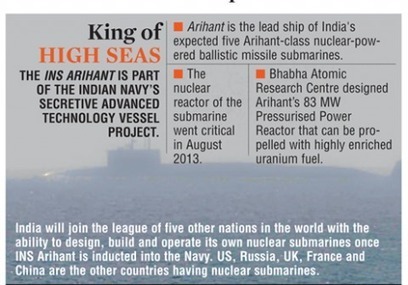

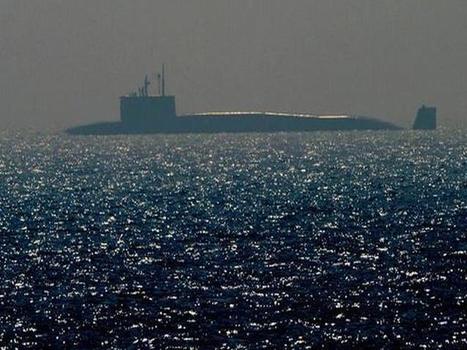
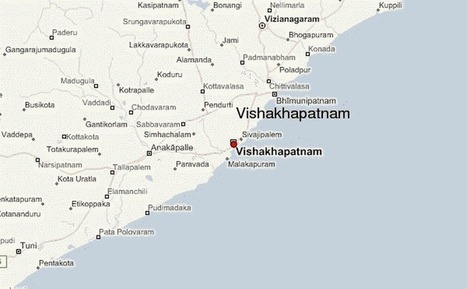
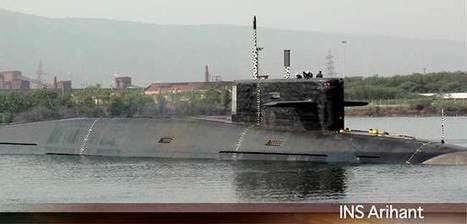
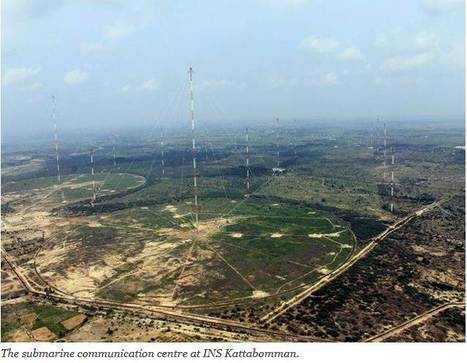

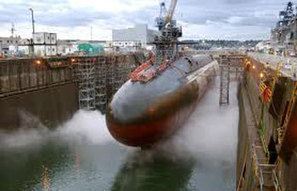
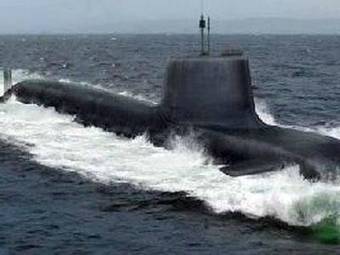

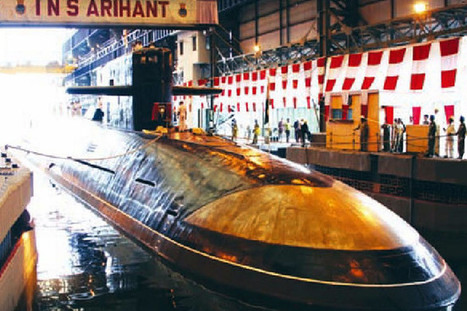

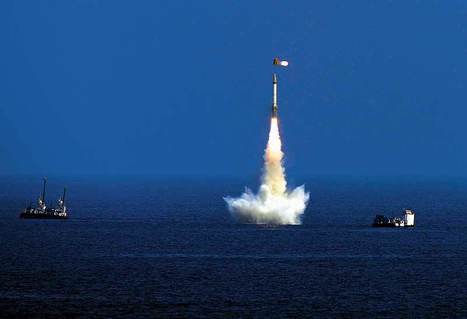
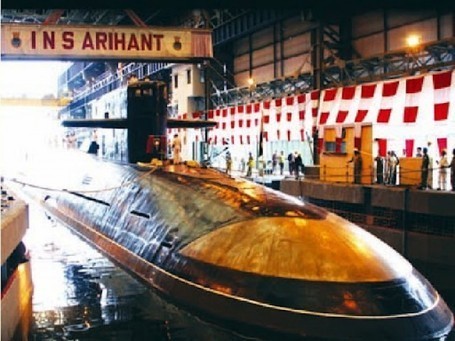
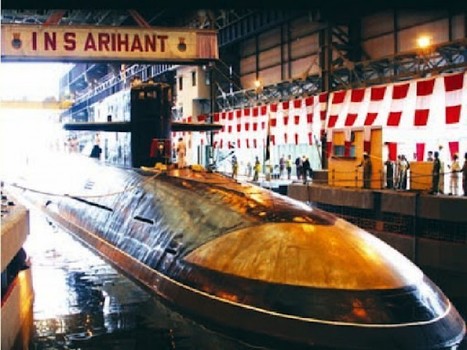





Le SNLE INS Arihant avait débuté ses essais à la mer à la mi-décembre 2014 :
http://sco.lt/8pTFsv